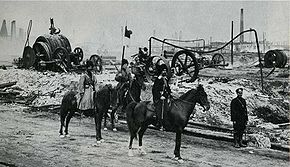This is an old revision of this page, as edited by 84.70.138.119 (talk) at 20:37, 10 February 2009 (Added a summary of what happened in Nakhichevan.). The present address (URL) is a permanent link to this revision, which may differ significantly from the current revision.
Revision as of 20:37, 10 February 2009 by 84.70.138.119 (talk) (Added a summary of what happened in Nakhichevan.)(diff) ← Previous revision | Latest revision (diff) | Newer revision → (diff)| Armeno-Tartar War | |||||||
|---|---|---|---|---|---|---|---|
 A Cossack military patrol near the Baku oilfields, ca. 1905. | |||||||
| |||||||
The Armenian-Tatar massacres (also known as the Armenian-Tartar War and the Armeno-Tartar War) refers to the bloody inter-ethnic confrontation between Christian Armenians and Muslim Caucasian Tartars throughout the Caucasus in 1905—1907.
The massacres started during the Russian Revolution of 1905, and claimed hundreds of lives. The most violent clashes occurred in 1905 in February in Baku, in May in Nakhichevan, in August in Shusha and in November in Ganja, heavily damaging the cities and the Baku oilfields. Some violence, although of lesser scale, broke out also in Tbilisi.
In Nakhichevan
After the Baku clashes, the Moslem communities in the Nakhichevan district began smuggling in consignments of weapons from Persia. By April the murder of Armenians there began to assume alarming proportions and they applied to the Russian authorities for protection. However, Villari describes the district's governor as "bitterly anti-Armenian", and the vice-governor in Yerevan as an "Armenophobe".
On the 25th May, acting on a prearranged plan, bands of armed Tartars attacked the market area in the district capital, the town of Nakhichevan, looting and burning Armenian businesses and killing any Armenians they could find. About 50 Armenians were murdered and some of the shopkeepers were burnt alive in their shops. On the same day, Tartar villagers from the countryside began attacking their Armenian neighbours. Villari cites official reports mentioning that out of a total of 52 villages with Armenian or mixed Armenian-Tartar populations, 47 were attacked, and of that 47, 19 were completely destroyed and abandoned by their inhabitants. The total number of dead, including those at Nachichevan, was 239. Later, in a revenge attack, Armenians attacked a Tartar village, killing 36 people.
-
 The house of a wealthy Armenian burnt down by Caucasian Tartars.
The house of a wealthy Armenian burnt down by Caucasian Tartars.
-
 An Armenian church in the Nakhichevan district "plundered and desecrated by Tartars".
An Armenian church in the Nakhichevan district "plundered and desecrated by Tartars".
-
 Monument in memory of the victims of 1905-1906 Armenian-Tatar Massacres in Berdadzor, Nagorno-Karabakh Republic
Monument in memory of the victims of 1905-1906 Armenian-Tatar Massacres in Berdadzor, Nagorno-Karabakh Republic
References
- Britannica Online Encyclopedia. Azerbaijan. History.
- Brockhaus and Efron Encyclopedic Dictionary. Turks
- Willem van Schendel, Erik Jan Zürcher. Identity Politics in Central Asia and the Muslim World: Nationalism, Ethnicity and Labour in the Twentieth Century. I.B.Tauris, 2001. ISBN 1860642616, 9781860642616, p. 43
- Villari, Luigi. Fire and Sword in the Caucasus. London: T. F. Unwin, 1906 ISBN 0-7007-1624-6 p. 270.
- Villari, Luigi. Fire and Sword in the Caucasus. London: T. F. Unwin, 1906 ISBN 0-7007-1624-6 p. 285
- Villari. Fire and Sword, p. 290
Bibliography
- Thomas De Waal (2004), Black Garden: Armenia and Azerbaijan Through Peace and War, NYU Press, ISBN 978-0-8147-1945-9
External links
This Armenian history-related article is a stub. You can help Misplaced Pages by expanding it. |
This Asian history–related article is a stub. You can help Misplaced Pages by expanding it. |